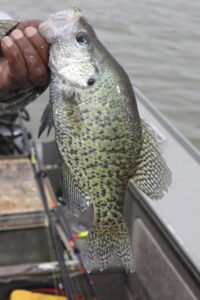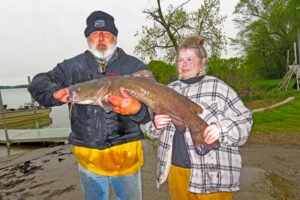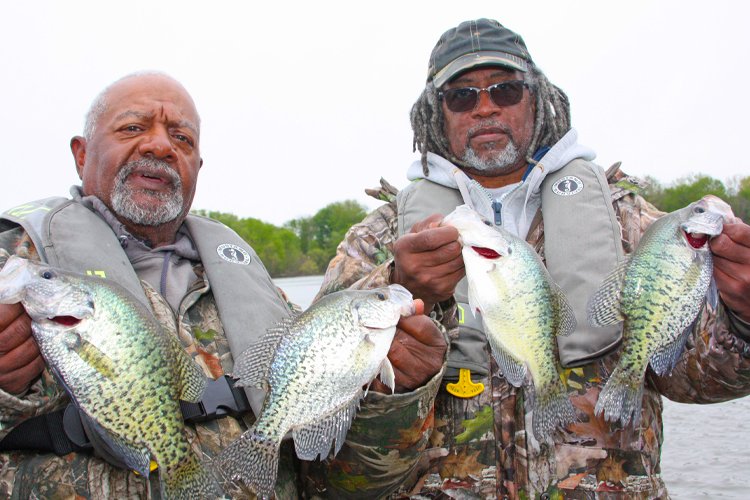Ken Smith (left) and buddy Tim Odem enjoy a rainy morning of crappie fishing on Mosquito Lake.
Destination: Mosquito Creek Lake, Ohio
by Darl Black
Mosquito Creek Lake in northeast Ohio is part of the Ohio/PA crappie triad – one of three outstanding crappie-producing waters near the border of these two states. Pymatuning Lake and Shenango Lake are the other two triad members, both of which have been reviewed previously in CRAPPIE NOW.
Crappie-catching guru Ken Smith, who makes his home only 25 minutes from Mosquito in western Pennsylvania and just minutes from Shenango Lake, has been fishing all three of these lakes for more than 40 years. But don’t ask him which of the three lakes he prefers – it’s a question for which he has no definitive answer.

“Each lake has its own personality, and from my viewpoint, there are reasons to fish all three depending on the time of year. I favor Pymatuning in the very early spring at ice-out, Shenango in late summer and fall, and Mosquito is my favorite in the late spring through the early part of summer,” explains Ken. “Personally, based on my style of fishing, I find Mosquito to be the easiest of three to fish.”
Ken backs up his opinion with this analysis: Although both Shenango and Mosquito are Army Corps flood control reservoirs, Mosquito maintains a more uniform level compared to Shenango Lake, which can go through extreme unexpected fluctuation in the spring and summer due to rainfall. Furthermore, Mosquito has clearer water than Shenango, likely due to the weed growth in Mosquito; Shenango has no weeds to filter suspended particulate in the heavy runoffs the lake receives.
Regarding Pymatuning, Ken points out that Pymie crappies tend to move around a lot in the late spring and summer, with many fish leaving spawning areas quickly to roam open water. Every time he visits the lake, Ken must take time to relocate a school of fish. Sometimes they are rather shallow, other times deeper.
“However, it is my experience Mosquito crappies tend to hang around the same depth and structure from pre-spawn through early summer – at least in the section of the reservoir that I fish,” continues Ken. “Mosquito crappies – both black crappies and white crappies – like high spots (humps, old roadbeds) with some wood or weed cover. Throughout the years I’ve fished Mosquito, I’ve never had to fish deep – seven foot is my go-to depth most of the time, or little shallower if it’s a brushpile on a flat. I have discovered dozens of such spots within 1/2 mile of the Causeway on both north and south side.”
Ken’s two most frequent presentations are jig & bobber and hang-gliding (his signature slow-troll vertical presentation for fishing deeper water.) However, on Mosquito Lake, Ken rarely finds it necessary to hang-glide deep water, as he must routinely do on the other area lakes. All his fishing is done with a bobber & jig.
A small clip-on bobber is set so the jig reaches crappies observed on his electronics – up to about 9-feet deep. A long cast is made and the rig is retrieved very, very slowly through the group of fish.
“It is my experience Mosquito crappies tend to hang around the same depth and structure from pre-spawn through early summer,” says Ken Smith.
“The jigs I use are either hair which I tie myself or small soft plastic bodies resembling a shad. My favorite plastics are the 1/25-inch Itty Bit Swim’r and 2-inch Baby Shad, both from Bobby Garland. If I’m using a 1/64-ounce jighead, I go with a weighted bobber, but if using a 1/32 or 1/16-ounce jighead, I go with an unweighted bobber,” explains Ken. “I never add a minnow to any jig. However, I do use a Berkley Crappie Nibble on each bait to provide an attracting scent.”
Ken does not believe a single color is going to produce crappies on any given lake all the time. He will begin the day with one – likely the one that produced last time out, and work through different colors if not getting sufficient number of bites. That being said, upon further questioning, he admits that white is the most consistently productive color on Mosquito.
In addition to an abundance of crappies, Mosquito is known for its flathead catfish. If you can stay awake through the night after a day of crappie fishing, you might connect with a monster after dark.
A source for up-to-the-minute local fishing information is the Causeway Bait & Tackle at 2233 Greenville Rd NE, Cortland, OH 44410; phone 330-637-7076.

Unlike many Army Corps impoundments where the Corps controls the recreation facilities around the lake, at Mosquito Creek Lake the surrounding recreation is under the jurisdiction of the Ohio Department of Natural Resources State Park System. Mosquito State Park provides a range of facilities and activities at the 7,850-acre lake, of which 7,200 acres are open to fishing and boating. A wildlife refuge is located on the far north end of the lake.
(Darl Black has been fishing since he was old enough to pick up a fishing rod. He penned his first angling article in the mid-1970s on a now-extinct writing device called a typewriter. During his career as an outdoor writer and photographer, Darl has fished throughout the US and Canada for many freshwater species but still enjoys fishing for crappies.)
Five boat ramps are located around the lake, plus a full-service marina at the south end near the dam. Although there is no horsepower restriction on Mosquito, there are certain areas with speed restrictions.
A state park managed campground with 234 sites is on the east shore. In addition to the usual picnicking and swimming opportunities, visitors to the lake who do not intend to fish 12 hours a day, can enjoy an archery range, disc golf, hiking trials, a mountain bike trail and horseback riding trail. For more details on Mosquito Lake, visit this web page.


